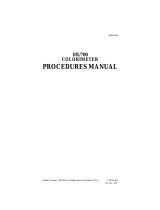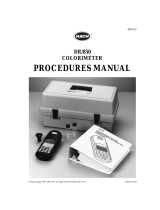Page is loading ...

www.cem.com [email protected]m 704-821-7015 800-726-3331
XpressVap User Guidelines & Tips
Application
The XpressVap device is designed to evaporate reagents (acid, water) following digestion or
evaporate/concentrate liquid samples prior to digestion.
The XpressVap device is not designed for evaporation of low boiling, flammable solvents such
as methanol or acetone, or for non-microwave absorbing solvents such as hexane.
Evaporation of nonflammable solvents or mixtures of nonflammable and flammable solvents
where the mixture has low flammability (ex. 90/10 proportion of water/ethanol as in wine)
is permitted. Proper safety precautions should be observed.
When evaporating permissible solvents, ensure that the scrubber is not affected by the
solvents being evaporated. If the user wishes to recover the solvent, a common cold trap
can be inserted between the microwave and the scrubber or in place of the scrubber.
The XpressVap assembly will accommodate 10mL, 20mL, and 55mL Xpress vessel liners. A
shorter thermowell is required for 10mL and 20mL liners. 75mL Xpress liners and Xpress Plus
liners will not fit into the assembly.
Setup
Scrubber Bottles
Bottle #1 (100 diffuser balls) – 1000mL H2O or 4% H3BO3 if using HF
Bottle #2 (50 diffuser balls) – 1000mL 25% NaOH
Bottle #3 (50 diffuser balls) – 1000mL H2O
Connecting the ¼” tubing correctly from bottle to bottle is very important. This will
prevent liquid from going bottle to bottle and eventually into the vacuum pump.
On the scrubber bottles, the port with the tubing attached to the underside of the cap is
the inlet, and the port without the tubing is the outlet.
XpressVap Assembly Tips
There must be at least six liners in the turntable to properly balance and seat
the manifold onto the vessel covers. Make sure the liners are spaced evenly in the
turntable, grouping two liners per manifold cover assembly.
A turntable adaptor is not required for the XpressVap turntable.
Rev 1
Date: 26 March 2015

When installing the thermowell into the control vessel, place the control manifold cover assembly on the
liner and remove the locking nut. Insert thermowell so that it touches the bottom of the liner. Replace
locking nut and finger tighten. This will ensure that the temperature probe is beneath the level of the
liquid, critical for monitoring the plateau and T.
Place the manifold arm assembly onto the vessel caps. It is not critical where the control vessel (with the
fiberoptic probe) is located relative to the vacuum line. However, the optimum position for the control
vessel is right next to the vacuum line as in the picture below. You may want to label or mark this
position as a reminder on future setups.
If all 24 (twenty-four) positions are not being used, make sure that a manifold plug is
placed in the unused manifold ports.
When tightening the retaining nut, finger tighten, then ~ ½ - ¾ turn with locking nut
wrench. DO NOT overtighten; this will cause the manifold arms to turn upward,
resulting in uneven seals and inconsistent final volumes. In addition, the threads may
strip if they are overtightened.
XpressVap – How it Works
The method above will ramp the vessels evenly to 80°C in 5:00 minutes. After the ramp is finished, the
software will automatically apply the programmed power (600W) to the samples. The software will
automatically detect the boiling point (PLATEAU) and continue to apply power until the temperature
changes from the detected boiling point to the DELTA temperature that is programmed (20°C above or
below the Plateau temperature). Once the Delta is achieved, the method will stop.
Stage
Ramp (min)
Hold (min)
Temperature (°C)
Delta (°C)
Power (w)
1
5:00
00:00
80
20
600

XpressVap Method Parameters
Program the XpressVap method in the Classic Directory.
Control Type: Select Evaporation
Plateau: The Plateau is the boiling point of the reagent(s) and is automatically
determined by the software based on a T/time algorithm. “Finding Plateau” is
displayed while the boiling point is being determined. Once it is found, “At Plateau” is
displayed for the remainder of the program.
Note: The temperature reached during the plateau stage may be lower than the actual
boiling point since the sample is under a vacuum. The temperature will remain at or
close to the plateau point until the solution boils down below the tip of the fiber optic
temperature probe.
Delta: The Delta is the change is temperature from the Plateau at which the program
will be terminated. Once the volume of solution is below the tip of the fiber optic
probe, the temperature will begin to decrease until the T requirement is met. The T
entered will determine the final volume.
General rule of thumb:
A larger T will result in a smaller final volume.
A smaller T will result in a larger final volume.
NOTE: The T can be positive or negative based on the boiling point of the reagents.
Temperature: The temperature that is entered into the method should be
substantially lower than the boiling point of the acid/reagent in question. For example,
program 80C for HNO3 and 75C for H2O. This is done to heat the vessels
evenly and prevent loss of sample volume prior to the program obtaining its plateau.
Ramp Time: 5:00 minutes is recommended as a good starting point. At the end of the
Ramp time the software will apply the programmed power to the samples and look for
the boiling point (PLATEAU) based on a T/time algorithm. NOTE: The software
will not look for a Plateau until the Hold Time expires.
Hold Time: For routine evaporation methods, program a Hold time of 00:00
minutes. A Hold Time greater than 00:00 minutes is programmed when there is a
mixture of reagents with different boiling points, and it is necessary to boil off one reagent prior to finding
the plateau of the other. For example, if you wish to evaporate HNO3 from a mixture of HNO3 + H2SO4,
program a Hold Time of 5:00 minutes. The software will hold the temperature at the programmed control
point for 5:00 minutes to allow HNO3 to evaporate off. At the end of the Hold Time, the software will
apply power and look for a Plateau.
Power: 600W is recommended. Because there is very little “load” in the microwave
cavity at the end of the evaporation step, DO NOT apply more than 800W when using
XpressVap.
/



